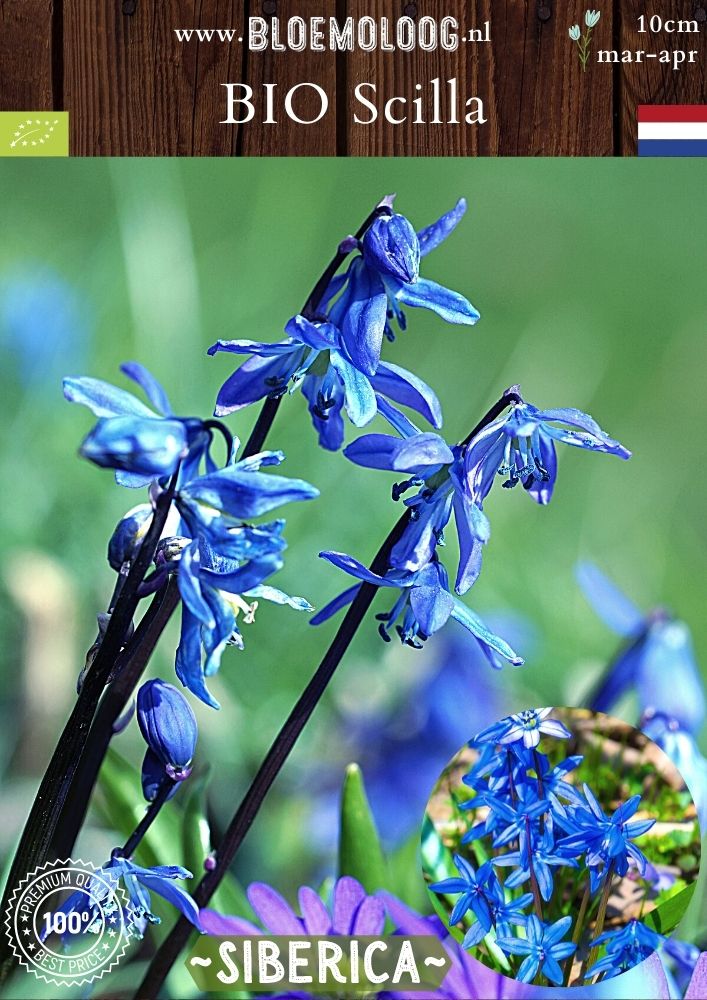Bloemoloog
Organic Scilla 'Siberica' - Siberian squill | 10 pcs.
Organic Scilla 'Siberica' - Siberian squill | 10 pcs.
Estimated Shipping Widget will be displayed here!
Couldn't load pickup availability
Organic Siberian Squill
Discover the Scilla 'Siberica', also known as the 'Siberian squill' or 'wood squill'. This early bloomer shows off its beauty in March and April. Though modest in height, just 10 centimeters, it produces two to three striking, star-shaped blue flowers per stem that bring a vibrant touch to your garden.
What truly sets this flower apart are its spotless petals, each marked with a deep blue stripe down the center. It’s a subtle detail that adds elegance and grace. During bloom, the broad, fresh green leaves reach the same height as the flower stems, creating a balanced and refined look in your garden beds or borders.
Looking to create a colorful carpet of blue and green? This Eastern beauty is the perfect choice. Not only is she beautiful, but also strong and dependable.
How, Where, and When to Plant Scilla 'Siberica' Bulbs
The best time to plant the bulbs is between September and January. Plant them at a depth of about three times the height of the bulb, and space them approximately three times the width of the bulb apart.
Scilla 'Siberica' naturalizes beautifully. For the best results, choose a sunny or partially shaded spot with moist, well-draining soil. Avoid overly wet conditions, as this can lead to bulb rot. If you have heavy clay soil, improve drainage by mixing in some compost or other organic matter.
Care Instructions
During the growing season, especially in dry weather, regular watering is recommended. Keep the soil lightly moist, but avoid waterlogging. This variety requires little fertilization. If you'd like to give it a boost, apply a gentle organic fertilizer in early spring when growth begins.
After blooming, let the foliage die back naturally. The leaves continue to store energy in the bulb for next year’s flowering. Only remove the leaves once they’ve fully yellowed and wilted. You may deadhead the faded blooms for a tidier look. Aside from that, the plant is very low-maintenance.
Propagation
Over time, the bulbs may multiply and become crowded. You can gently lift and divide them, then replant them elsewhere in your garden to give them more space and extend the display of flowers.
Origin
Scilla 'Siberica' originates from the mountainous regions of Central Asia, including Siberia and Kazakhstan. Hence the name 'Siberica'. It belongs to the Scilla genus, part of the asparagus family (Asparagaceae), and is often considered a stinzenplant, a type of perennial traditionally found in historic estates and gardens.
Order Info for Organic Scilla 'Siberica'
✅ Skal certified: 109459
📦 Packed per 10 bulbs or choose a stacking discount.
💰 Stacking discount: E
🛒 Pre-order now – Shipping mid-September!
📬 EU Shipping €8.95 – Free shipping on orders over €100.
Characteristics
| Flowering period: | March - April |
| Planting period: | From September |
| Planting depth: | 7 cm deep |
| Spacing: | 7 cm apart |
| Height: | 10 cm |
| Flower diameter: | 5 cm |
| Location: | Partial shade, sun |
| Soil pH: | Clay, loam, sandy soil - Slightly acidic to neutral |
| Hardiness: | Fully hardy |
| Propagation: | Excellent (naturalizes) |
| Origin: | Siberia |
| Family: | Asparagaceae (Asparagus family) |
| Color: | Blue |
| Bee-friendly: | Yes |
| Fragrant: | No |
| Bulb size: | 5+ |

NL-BIO-01
To share


